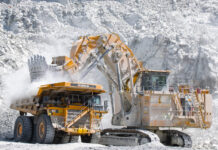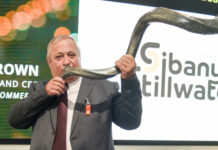
ANGLO American CEO Duncan Wanblad said he was untroubled by the performance of the share price since Anglo rejected BHP’s takeover proposal. The stock has fallen about 15% since May 29.
Instead of accepting BHP’s £29.34 a share offer, Wanblad rolled out a major restructuring of Anglo. By the end of 2025 the company ought to have unbundled Anglo American Platinum and divested the metallurgical coal mines in Australia. De Beers will either be sold or demerged in a two-track process that will see Anglo prepare a prospectus even as it speaks to prospective buyers.
Asked about the retreat in Anglo’s share price, Wanblad says: “If I have a look at what’s happened at other businesses [that restructured], the re-rating happens much closer to the end of the process. I’m very optimistic we will get a rerating as we start to deliver against our promises.”
The intention of the restructuring is to highlight the value of Anglo’s copper assets in South America. Where once Anglo owned or ran a major portion of South African industry, it will now — but for iron ore production, which it is retaining — become an option on the copper price.
Given that BHP and Rio Tinto, as well as Glencore, have walked similar roads of simplification, Anglo’s restructuring signals for some the end of the diversified company. This is the time-honoured investment model in which shareholders are partly insulated from the down cycle in one metal through the cash flow from a better-performing one.
“I do think simplification is what the market is looking for,” says Wanblad, speaking after the group’s interim results presentation in July. “It’s definitely changing. The highly complex corporate structure with a whole host of underlying commodities is not desired by the market any more.”
This is reflected in recent mining company valuations, according to Goldman Sachs research. “Despite the strong fundamentals of the diversified miners, they do not currently command the valuations they have seen in the past or the current valuation of the copper miners,” says the bank’s mining analyst, Matt Greene.
The mining sector is also seeing an influx of “targeted capital seeking clean, single-metal exposure that aims to avoid the complexities associated with understanding a broad spectrum of industrial and consumer commodities”, Greene says.
Investors may also be mindful of the overspend in the mining sector between 2003 and 2013 that resulted in huge writedowns — more than $60bn worth, according to estimates.
Complexity premium
But as companies get smaller, the projects become more complex. Mineral deposits are lower in yield, and technically harder to mine for profit. Today’s projects also take longer to permit owing to a tightening in the regulatory framework, itself a consequence of changing ideas over mineral custodianship. Water, community approval and environmental impact are political hot potatoes, especially in developing economies, but not exclusively.
A new copper mine takes more than 20 years to build from discovery, as demonstrated by Anglo’s Quellaveco mine in Peru (which took 30 years). Another mine, BHP/Rio Tinto’s Resolution, was discovered in 1995 and spent nearly a decade on its environmental impact permit process.
The greater the time factor, the greater the capital intensity. A study of seven copper projects in Latin America by Goldman Sachs found that the average capital intensity of a project rose 50% between pre-feasibility-study stage and production.
As a result, so-called big mining is having to consider collaboration. “We will see more joint venture agreements to bring together very big capital-intensive projects,” Wanblad predicts.
“There is a threshold scale that is required to support copper, especially where we are seeing capital intensity increase quite significantly. So scale is important. Having some type of diversification, where you have a little bit of a cash engine as well as a growth engine, will become important,” he says.
We expect meaningful progress with the restructuring over the next 12 months – UBS
The largest mining project in the world today is Simandou, an iron ore deposit in Guinea. Such is its scale, the $20bn project has been divided into concessions run by consortia, including Rio Tinto in one half of the deposit, and a large Chinese consortium on the other. Anglo sold 40% of its Quellaveco project to Mitsubishi. According to auditing firm PwC, the mining sector is also turning up in some unlikely partnerships, including new mining companies founded by sovereign states.
In an effort to diversify from oil and gas, Saudi company Ma’aden formed a joint venture — Manara Minerals — with the country’s public investment fund. Manara Minerals is now in talks to buy a stake in Pakistan’s Reko Diq copper-gold mine, where Barrick Gold is anchor investor and developer. In another example, Rio Tinto teamed up with Sumitomo and the Australian Renewable Energy Agency to investigate green hydrogen in power-intensive aluminium smelting.
Another consequence of the difficulty of building new projects is increased mergers & acquisitions. It’s cheaper for established miners to buy competitors than build a new mine, hence BHP’s tilt at Anglo. One popular view is that BHP will renew its interest in Anglo once the UK-listed miner has completed its restructuring. For Anglo to survive that it needs to make itself as expensive as possible, requiring investors to approve of Wanblad’s strategy.
Interestingly, shares in Anglo outperformed rivals in the days following its interim results, up 4% on July 26 alone.
“We expect meaningful progress with the restructuring over the next 12 months,” UBS said in a report in which it upgraded Anglo from neutral to buy and set a £27 a share target price. “We expect Anglo to rerate as the group simplifies; if not, we see potential for another takeover approach,” it added, ominously for Wanblad.
A version of this article first appeared in the Financial Mail.











